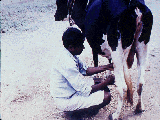 CIESIN Thematic Guides
CIESIN Thematic Guides

Reducing Methane Emissions from Livestock
Livestock emit significant amounts of methane to the atmosphere as a by-product of digestion. According to Changing by Degrees (U.S. Office of Technology Assessment 1991), opportunities exist for reducing, or at least limiting, the growth rate of livestock methane emissions by increasing digestion efficiency and/or animal productivity (the increase in live weight produced per unit of feed). Emission reductions of 25 to 75 percent per unit of product are possible, with more potential for change in developing countries. The U.S. Environmental Protection Agency reports in Policy Options for Stabilizing Global Climate (1990) that this range of possible emissions reductions corresponds roughly to a 2- to 5-percent reduction in global methane emissions (Lashof and Tirpak 1990). Chapter 8 of Changing By Degrees (U.S. Office of Technology Assessment 1991) addresses a broad range of existing and emerging technologies to reduce methane production from livestock.
Chapter 6 of Preparing U.S. Agriculture for Global Climate Change examines improved efficiencies, decreased consumption of ruminant livestock products, and improved biotechnology as strategies for emitting less and sequestering more methane from livestock (Council for Agricultural Science and Technology 1992). The strategies are applied mainly to the United States, where 10 percent of the world cattle and buffalo population is located.
In "Quantitative Ruminant Nutrition - A Green Science," Leng (1993) presents strategies for reducing methane emissions based on experiments to decrease enteric methane production. Figure 6 and figure 7 illustrate that massive reductions in methane production per unit of metabolizable energy intake and live weight gain are possible by using feed supplements.